Butterfly wing patterns are a mesmerizing testament to the beauty and artistry of nature. From vibrant colors to intricate designs, these delicate creatures showcase a stunning array of variations. In this comprehensive guide, I will take you on a journey through the enchanting world of butterfly wing patterns, uncovering their secrets and exploring their significance.
Key Takeaways:
- Butterfly wing patterns exhibit a wide range of variations, showcasing nature’s artistry and beauty.
- Each butterfly species has its unique wing design, featuring vibrant colors and intricate patterns.
- Wing patterns serve various functions, including mate attraction, camouflage, and warning signals for predators.
- Genetics play a significant role in determining wing patterns, while environmental factors also contribute to their variations.
- Butterfly wing patterns have cultural significance, inspiring art, fashion, and symbolism.
The Diversity of Butterfly Wing Patterns
Butterfly wings are renowned for their vibrant colors and intricate patterns, showcasing a remarkable diversity of hues and designs. Each species boasts its unique wing pattern, captivating observers with their exquisite beauty. From delicate stripes and intricate spots to mesmerizing eye spots, butterfly wing patterns are a feast for the eyes.
The color variations found in butterfly wings are as diverse as the species themselves. Some butterflies flaunt bold and vibrant hues, like the brilliant blues and radiant yellows of the Morpho butterflies. Others display subtle gradients and delicate pastels, creating a soft and ethereal effect. These color variations serve multiple purposes, from attracting mates to providing camouflage in their natural environments.
Patterns are another intriguing aspect of butterfly wings. Some species exhibit symmetrical stripes, forming a harmonious and balanced design. Others boast elaborate patterns of intricate spots and lines, creating a mesmerizing visual display. These patterns can serve as signals to potential mates or predators, with each marking and motif conveying a specific message.
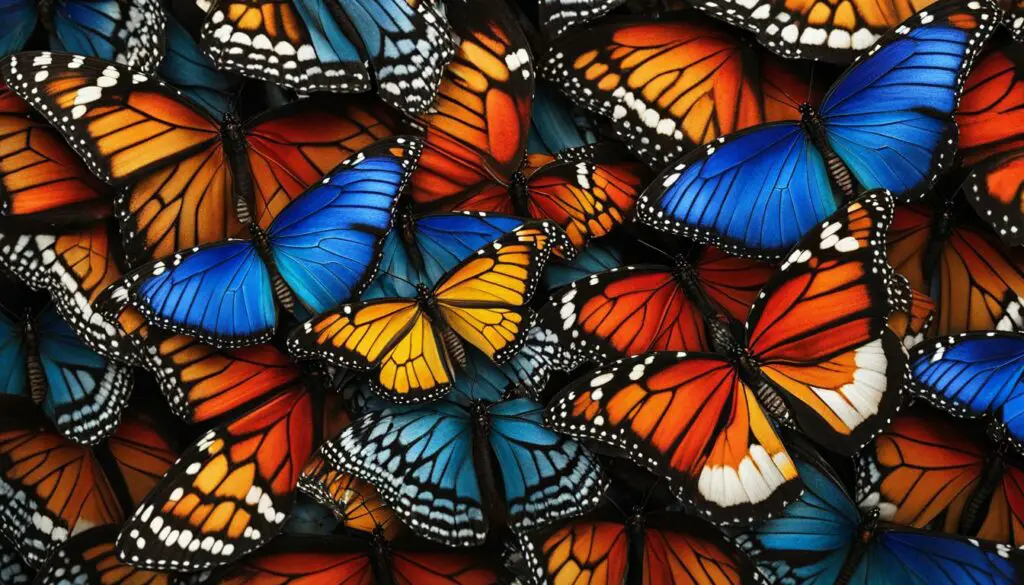
The Beauty of Butterfly Wing Motifs
One of the most captivating aspects of butterfly wings is the presence of unique motifs. Eye spots, also known as ocelli, are prominent features found on the wings of various butterfly species. These eye-like markings serve as a defense mechanism, intimidating and confusing potential predators. The strategic placement and vivid colors of these eye spots create an illusion of a larger and more threatening creature, deterring predators from approaching.
Butterfly wings are nature’s canvas, displaying an intricate masterpiece of colors, patterns, and motifs. Each species has its unique wing design, reflecting the fascinating diversity of the natural world.
As we explore the diversity of butterfly wing patterns, we gain a deeper appreciation for the wonders of nature’s artistry. The intricate color variations, patterns, and motifs of butterfly wings serve as a reminder of the incredible beauty and complexity that exists within the natural world.
Adaptations and Survival Strategies
Butterfly wing patterns are not just visually striking; they also play a crucial role in the survival of these delicate creatures. These patterns have evolved over time to serve specific functions and provide advantages for butterflies in their natural habitats. Let’s explore some of the remarkable adaptations and survival strategies associated with butterfly wing patterns.
Mimicry and Camouflage
One fascinating adaptation is camouflage. Some butterfly species have developed wing patterns that mimic the appearance of leaves, twigs, or bark, blending seamlessly into their surroundings. This remarkable mimicry allows them to hide from predators, increasing their chances of survival. By resembling inanimate objects, butterflies can avoid detection and potential attacks.
In addition to camouflage, certain butterfly wing patterns are designed to mimic toxic or unpalatable species. These patterns serve as a warning to potential predators, signaling that the butterfly is not a suitable meal. Through mimicry, butterflies gain protection by taking advantage of the learned aversion predators have towards their toxic counterparts.
Warning Signals
For some butterfly species, vibrant and bold wing patterns act as warning signals. These patterns, often accompanied by bright colors, communicate to predators that the butterfly is toxic or unpalatable. When predators encounter a butterfly with such a pattern, they associate the visual cues with unpleasant experiences, deterring them from attacking and consuming the butterfly. This warning mechanism allows butterflies to survive and thrive in environments where they may encounter predators.
Through a combination of mimicry, camouflage, and warning signals, butterfly wing patterns have evolved to provide adaptive advantages for survival. These visual characteristics are not only a testament to the beauty of nature but also demonstrate the intricate strategies butterflies employ to ensure their continued existence.
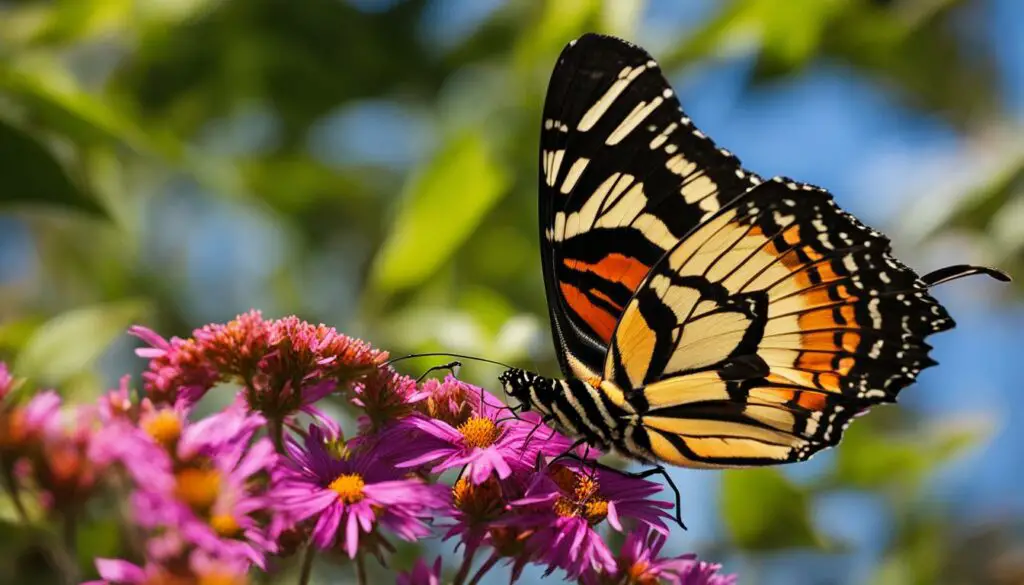
| Adaptation | Description |
|---|---|
| Camouflage | Butterfly wing patterns mimic leaves, twigs, or bark to blend in with the environment, providing effective camouflage and protection from predators. |
| Mimicry | Some butterfly wing patterns closely resemble toxic or unpalatable species, tricking predators into avoiding them due to learned aversion. |
| Warning Signals | Vibrant and bold wing colors and patterns indicate to predators that the butterfly is toxic or unpalatable, deterring potential attacks. |
The Genetics of Wing Pattern Variation
Butterfly wing patterns are not only visually stunning but also the result of intricate genetic processes. The immense diversity of butterfly wing patterns is influenced by specific genes that control their development. Scientists have been studying these genetic mechanisms to gain a deeper understanding of how the various patterns observed in different butterfly species are formed.
By analyzing the genes responsible for wing pattern variation, researchers have made significant discoveries about the genetic basis of butterfly wings. They have identified specific genes that play a role in determining the colors, patterns, and motifs found in butterfly wings. These genetic variations give rise to the remarkable diversity of wing patterns that exist in nature.
The study of butterfly wing genetics has revealed fascinating insights into the evolutionary processes behind these intricate designs. It has provided evidence of genetic adaptations that enable butterflies to survive in their environments. Understanding the genetic basis of wing patterns not only deepens our appreciation for the striking beauty of butterflies but also sheds light on the intricate interactions between genes and the environment.
| Genes | Wing Patterns |
|---|---|
| Gene A | Stripes and Spots |
| Gene B | Eyespots |
| Gene C | Color Variations |
This table illustrates some of the genes and the corresponding wing patterns they influence. Gene A is responsible for the formation of stripes and spots, while Gene B controls the development of eyespots. Gene C contributes to the range of color variations observed in butterfly wings. By understanding the specific genes involved in wing pattern variation, scientists can begin to unravel the complexity of butterfly genetics and its role in shaping these intricate designs.
Role of Environmental Factors
Environmental factors play a significant role in shaping the diverse and captivating wing patterns of butterflies. While genetics lay the foundation for these patterns, the environment provides the canvas on which they are expressed. Temperature, humidity, and the availability of specific pigments in the environment all influence the coloration and patterning of butterfly wings.
For example, in warmer climates, butterfly wings may display more vibrant and intense colors, while in cooler regions, they may appear more subdued. Additionally, variations in humidity levels can affect the development of specific wing patterns, resulting in unique color combinations and designs.
The interplay between genetics and environmental influences creates a stunning array of butterfly wing patterns that are tailored to their specific habitats. This adaptation allows butterflies to blend into their surroundings, attract mates, and even deter potential predators. It is a testament to the intricate relationship between these delicate creatures and the world they inhabit.

Mimicry and Coevolution
Butterfly wing patterns showcase not only nature’s artistic beauty but also serve as a critical tool for mimicry and coevolution. Some butterfly species have evolved to mimic the wing patterns of toxic or unpalatable species, fooling predators into thinking they are also dangerous. This adaptive strategy provides protection against predation and highlights the intricate relationship between butterfly wing patterns and their environment.
Mimicry is a fascinating phenomenon where one species evolves to imitate the appearance of another species. In the case of butterfly wing patterns, mimicry serves as a form of defense against predators. By resembling the wing patterns of toxic or unpalatable species, mimicking butterflies deter potential predators from attacking, as the predators have learned to associate those patterns with unpleasant or harmful experiences.
Coevolution, on the other hand, refers to the reciprocal evolutionary changes that occur between two or more interacting species. In the context of butterfly wing patterns, coevolution is exemplified by the intricate dance between mimicking butterflies and the species they imitate. As mimicking butterflies evolve to better resemble their toxic counterparts, the toxic species also undergo further adaptations to enhance their defenses. This ongoing evolutionary arms race leads to the development of increasingly sophisticated wing patterns and strategies for survival.
Mimicry and coevolution in butterfly wing patterns highlight the remarkable adaptability and interconnectedness of species within an ecosystem. These intricate relationships provide a glimpse into the fascinating world of evolutionary biology and the delicate balance of nature.
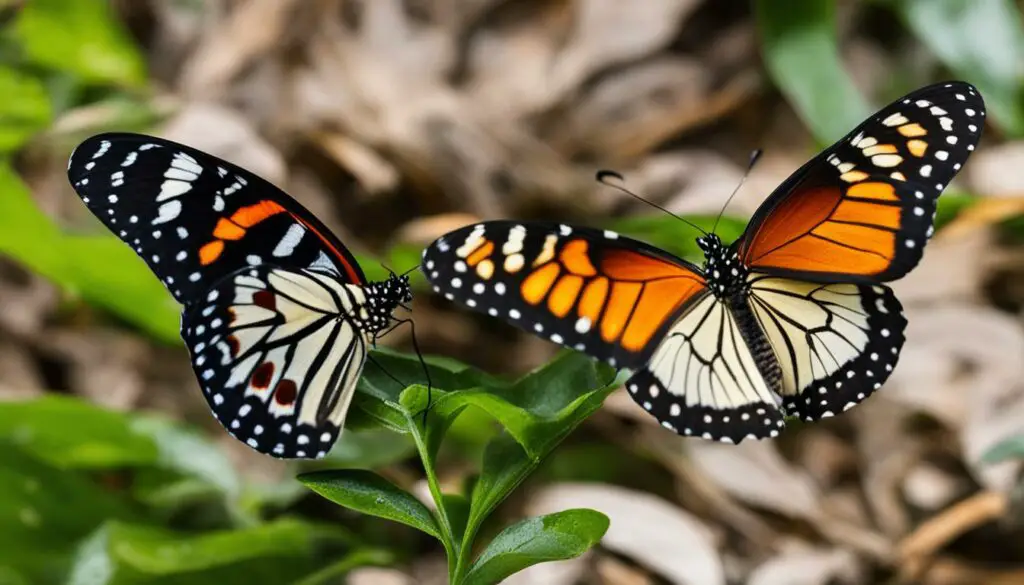
Coexistence and survival
The phenomenon of mimicry and coevolution in butterfly wing patterns is not only a testament to the adaptability of these insects but also signifies the intricate web of relationships that exist in ecosystems. Through mimicry, butterflies are able to coexist with toxic species, sharing habitats and resources while enjoying the benefits of predator deterrence. This coexistence allows for the survival of multiple species with varying levels of toxicity, creating a diverse and resilient ecosystem.
Furthermore, the fascinating nature of mimicry and coevolution in butterfly wing patterns serves as a reminder of the interconnectedness of all living beings. Every species plays a unique role in maintaining the delicate balance of nature, and the evolution of butterfly wing patterns is a testament to this intricate dance between predator and prey, survival and adaptation.
Conclusion
The phenomenon of mimicry and coevolution in butterfly wing patterns is a captivating example of nature’s ingenuity. Through the development of intricate wing designs, butterflies have evolved strategies for survival, fooling predators and coexisting with toxic species. This intricate dance between mimicry and coevolution highlights the interconnectedness of species and the delicate balance of ecosystems. As we marvel at the beauty and complexity of butterfly wing patterns, let us also recognize the importance of preserving these delicate creatures and their unique adaptations.
Table: Examples of Mimicry in Butterfly Wing Patterns
| Mimicking Butterfly | Species Mimicked | Wing Pattern |
|---|---|---|
| Morpho helenor | Morpho peleides | Blue iridescent wings with black borders |
| Papilio memnon | Bhutanitis lidderdalei | Black wings with pale yellow markings |
| Hypolimnas misippus | Amauris niavius | Brown wings with white spots and red patches |
Butterfly Wing Pattern Research
Research on butterfly wing patterns has provided valuable insights into the intricate world of these mesmerizing creatures. Scientists have dedicated extensive efforts to unraveling the genetic, morphological, and ecological aspects of butterfly wings, shedding light on the mechanisms behind their stunning variations.
Through genetic studies, researchers have identified key genes that control the development of wing patterns in different butterfly species. This understanding of the genetic basis of wing patterns has deepened our knowledge of the evolutionary processes shaping butterfly diversity.
In addition to genetics, scientists also investigate the role of environmental factors in shaping butterfly wing patterns. Studies have shown that temperature, humidity, and the availability of certain pigments in the environment influence the expression of specific wing patterns. This interplay between genes and the environment adds another layer of complexity to the study of butterfly wings.
Advancements in butterfly wing pattern research
Recent advancements in technology and scientific techniques have propelled the study of butterfly wing patterns further. High-resolution imaging and advanced morphological analysis allow researchers to examine wing structures in greater detail, uncovering hidden patterns and structures.
“The intricate beauty and diversity of butterfly wing patterns continue to inspire awe and curiosity. By unraveling the secrets behind these patterns, we gain a deeper understanding of the fascinating world of butterflies and the forces that have shaped their evolution.”
Furthermore, ongoing research in the field of mimicry and coevolution has revealed fascinating insights into the intricate relationships between butterfly wing patterns and their environment. Scientists explore how certain butterfly species have evolved to mimic the wing patterns of toxic or unpalatable species, providing them with protection from predators.
In conclusion, butterfly wing pattern research has provided a wealth of knowledge about the genetic, environmental, and evolutionary factors that contribute to the stunning variations observed in these delicate creatures. By delving deeper into the study of butterfly wing patterns, scientists continue to unlock the secrets of nature’s artwork and gain a deeper appreciation for the intricate beauty of butterflies.
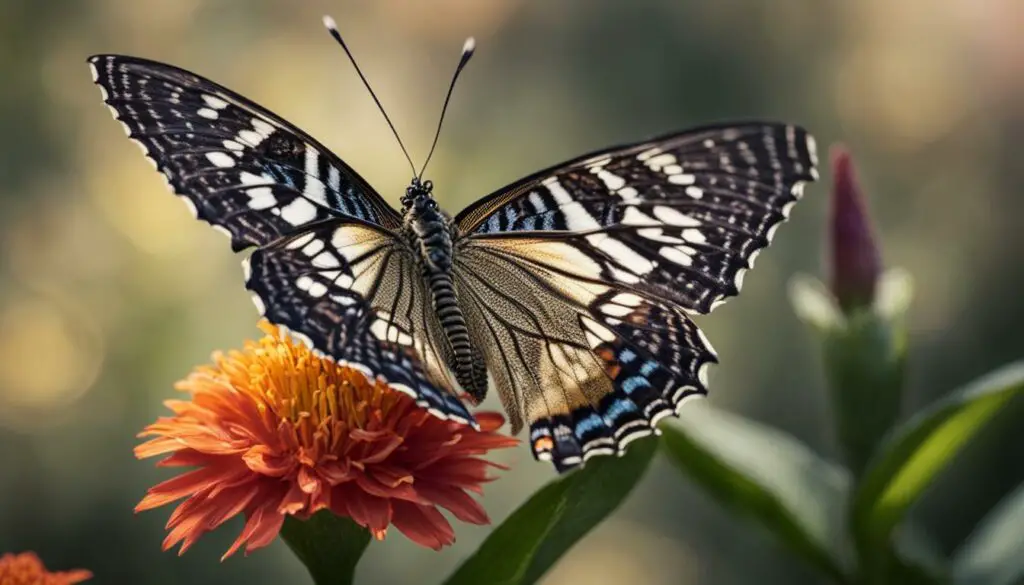
Cultural Significance of Butterfly Wing Patterns
Butterfly wing patterns have captured the imagination of cultures around the world, inspiring a myriad of artistic creations and symbolizing profound concepts. The delicate and intricate designs found on butterfly wings evoke a sense of awe and wonder, reflecting the beauty and complexity of nature. These patterns have become a source of artistic inspiration, influencing various art forms from paintings and sculptures to fashion and jewelry.
The symbolism of butterfly wing patterns is deeply rooted in the concept of transformation and rebirth. The butterfly’s life cycle, from a humble caterpillar to a graceful winged creature, represents the journey of personal growth and metamorphosis. It serves as a reminder of the inherent ability to overcome challenges and emerge stronger, inspiring individuals to embrace change and embrace their true potential.
“The butterfly counts not months but moments, and has time enough.” – Rabindranath Tagore
Artists from different cultures have drawn inspiration from the vibrant colors and intricate designs of butterfly wings, incorporating these elements into their creative works. The mesmerizing patterns and graceful flight of butterflies have been depicted in countless paintings, sculptures, and textiles. The transformative symbolism of butterfly wing patterns also extends to jewelry designs, where these delicate patterns are often incorporated into symbolic pieces to represent personal growth and spiritual transformation.
The Cultural Significance of Butterfly Wing Patterns
- Symbol of transformation and rebirth
- Inspiration for various art forms
- Representation of personal growth and embracing change
- Incorporated into jewelry designs symbolizing spiritual transformation
As we marvel at the intricate beauty of butterfly wing patterns, we are reminded of the importance of preserving these delicate creatures and their habitats. By understanding and appreciating the cultural significance of butterfly wing patterns, we are motivated to protect and cherish these mesmerizing works of nature, ensuring that future generations can continue to find inspiration in their captivating designs.
| Country | Symbolism of Butterfly Wing Patterns |
|---|---|
| China | Butterflies symbolize joy, marital bliss, and long life |
| Mexico | Butterflies are associated with the Day of the Dead and represent the souls of departed loved ones |
| Native American cultures | Butterflies are seen as messengers, carrying prayers and connecting the spiritual and physical worlds |
| Japan | Butterflies symbolize the soul and are believed to bring good luck and happiness |
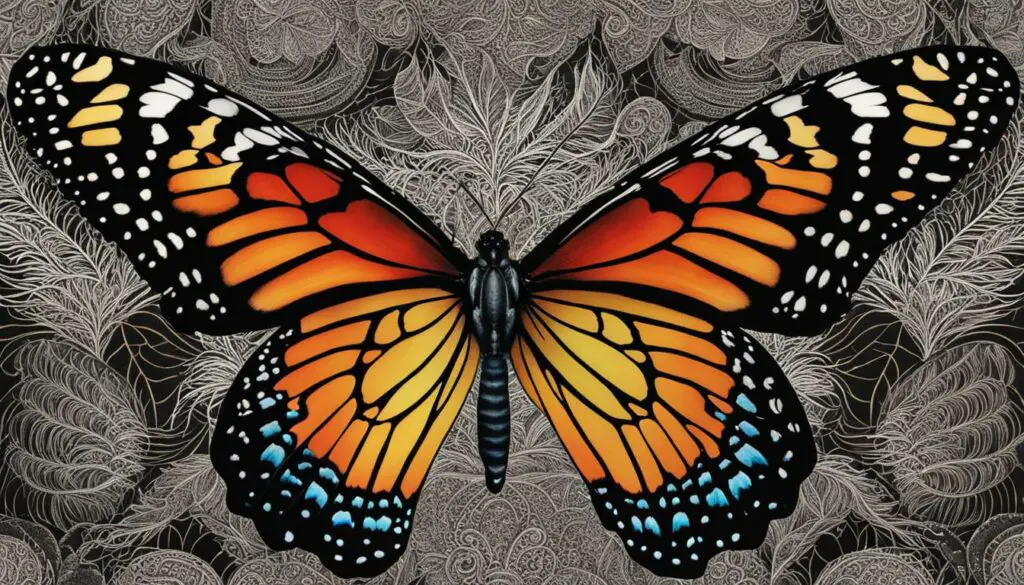
Conservation and Preservation of Butterfly Wing Patterns
Protecting butterfly habitats is crucial for the conservation and preservation of the mesmerizing wing patterns displayed by these delicate creatures. As human activities continue to threaten butterfly populations, understanding the significance of different wing patterns and their ecological roles becomes paramount. By taking proactive measures and promoting sustainable practices, we can ensure the continued existence of these enchanting wing designs.
Conservation efforts should focus on preserving the diverse habitats that support butterfly populations. These habitats provide essential resources such as host plants for breeding, nectar sources for feeding, and suitable climates for survival. Implementing measures to protect these habitats, such as creating nature reserves, restoring natural landscapes, and minimizing pesticide use, can help maintain the delicate balance of butterfly ecosystems.
Additionally, education and awareness play a vital role in conserving butterfly wing patterns. By spreading knowledge about the ecological importance of butterflies and their wing patterns, we can inspire individuals and communities to take action. Initiatives like butterfly conservation workshops, educational campaigns, and citizen science programs can empower people to contribute to the preservation of butterfly habitats and promote sustainable practices in their own lives.
| Actions for Conservation and Preservation | Benefits |
|---|---|
| 1. Establish protected areas and nature reserves | – Safeguard butterfly habitats – Allow populations to thrive |
| 2. Restore native plant species | – Provide essential resources for butterflies – Enhance biodiversity |
| 3. Reduce pesticide use | – Minimize negative impacts on butterfly populations – Preserve habitat quality |
| 4. Foster community involvement | – Engage individuals in conservation efforts – Raise awareness and support for butterfly conservation |
By taking a holistic approach to butterfly conservation, we can ensure the survival of these enchanting creatures and their intricate wing patterns for future generations to admire. Let us be stewards of nature’s beauty and work together to protect and preserve the delicate artistry of butterfly wings.
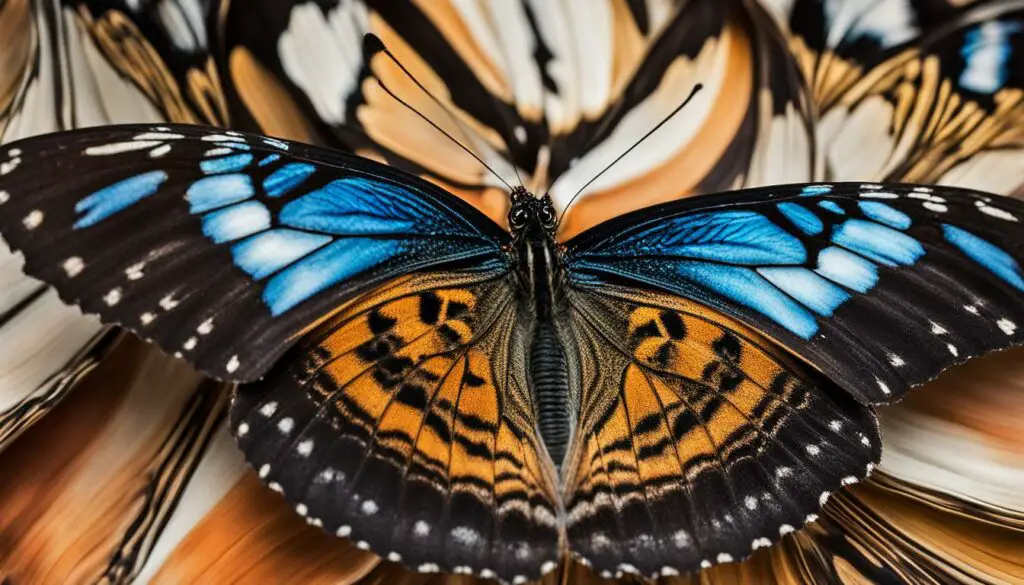
Importance of Protected Areas and Nature Reserves
Protected areas and nature reserves play a crucial role in safeguarding butterfly habitats and preserving their wing patterns. These designated spaces provide a safe haven for butterflies to breed, feed, and thrive. By establishing and effectively managing protected areas, we can create sanctuaries that allow butterfly populations to flourish, ensuring the long-term preservation of their captivating wing patterns.
Educating and Inspiring Butterfly Enthusiasts
As a butterfly enthusiast, I find great joy in exploring the intricate world of butterfly wing patterns. These mesmerizing designs not only captivate the eye but also provide valuable insights into the beauty and complexity of nature. By delving into the study of butterfly wing patterns, we can gain a deeper appreciation for these delicate creatures and play a crucial role in their conservation.
For butterfly novices and enthusiasts alike, education is key to fully understanding and appreciating the incredible diversity of butterfly wing patterns. By learning about the different species, their unique wing designs, and the ecological roles they play, we can develop a better understanding of the interconnectedness of nature. Whether it’s through scientific studies, field observations, or engaging with butterfly experts, there are endless opportunities to expand our knowledge and become advocates for these enchanting insects.
Beyond education, studying butterfly wing patterns can also inspire our own creativity and artistic endeavors. The vibrant colors, intricate details, and elegant motifs found in butterfly wings have long been a source of artistic inspiration. Painters, photographers, and fashion designers draw upon these exquisite designs to create stunning works of art that celebrate the beauty of nature. By immersing ourselves in the world of butterfly wing patterns, we can tap into our own creativity and foster a deep connection with the natural world.
Quotes:
“The intricate and diverse patterns found in butterfly wings remind us of the endless wonders nature has to offer.” – Butterfly expert
Table: Comparison of Butterfly Wing Patterns
| Butterfly Species | Wing Pattern | Color Variation | Function |
|---|---|---|---|
| Monarch Butterfly | Black and orange stripes with white spots | Limited variation | Warning signal to predators |
| Peacock Butterfly | Eye spots with iridescent blue and green patterns | Various shades of blue and green | Mate attraction and camouflage |
| Swallowtail Butterfly | Black and yellow stripes with red spots | Some variations in stripe thickness | Camouflage in foliage |
By immersing ourselves in the intricate world of butterfly wing patterns, we can not only expand our knowledge but also become advocates for their conservation. As butterfly enthusiasts, we have the power to inspire others to appreciate the delicate beauty of these creatures and take action to protect their habitats. Together, we can ensure that future generations will continue to marvel at the exquisite artistry displayed in butterfly wings.
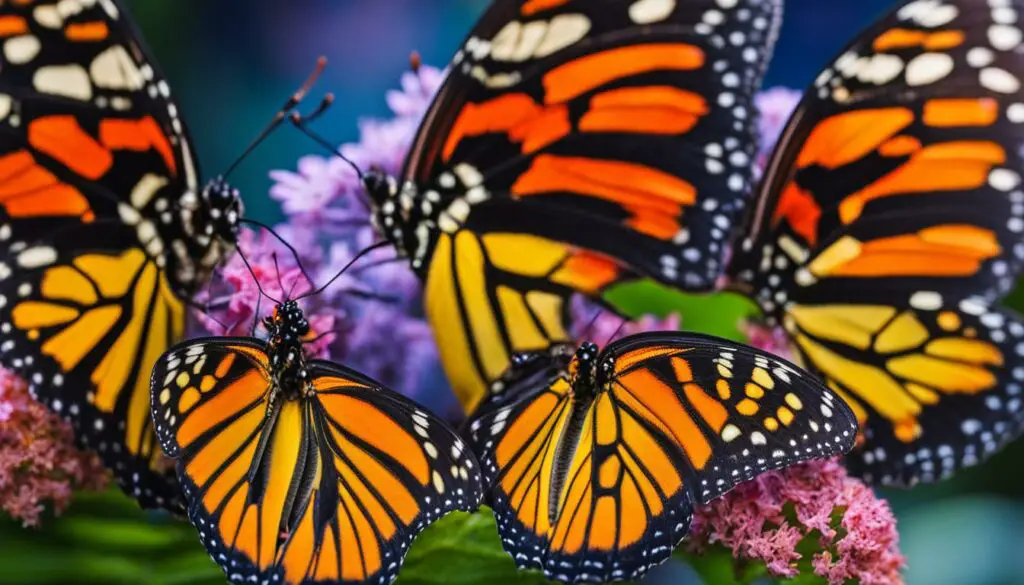
Exciting Discoveries in Butterfly Wing Pattern Variation
In recent years, there have been fascinating scientific advancements in our understanding of butterfly wing pattern variation. Researchers have made significant strides in identifying the specific genes responsible for the development of these intricate designs. By studying the genetic makeup of different butterfly species, scientists have unraveled the secrets behind the stunning diversity of wing patterns observed in nature.
One remarkable discovery is the role of environmental factors in influencing butterfly wing patterns. Researchers have found that factors such as temperature, humidity, and the availability of certain pigments in the environment can impact the expression of specific wing patterns. This interplay between genes and the environment provides valuable insights into how butterfly wings adapt to their surroundings and evolve over time.
“The intricate relationship between butterfly wing patterns and their environment demonstrates nature’s remarkable ability to adapt and evolve.”
Another exciting area of research is the study of mimicry and coevolution in butterfly wing patterns. Some butterfly species have evolved to mimic the wing patterns of toxic or unpalatable species, offering them protection against predators. This remarkable adaptation showcases the intricate relationship between butterfly wing patterns and their environment, highlighting the dynamic processes at play in the natural world.
Overall, these recent discoveries in butterfly wing pattern variation have opened the door to further exploration and understanding of the evolutionary processes shaping these intricate designs. By delving deeper into the genetic and environmental factors that influence wing patterns, scientists are unlocking the mysteries of nature’s artwork and gaining valuable insights into the remarkable adaptations of butterflies.
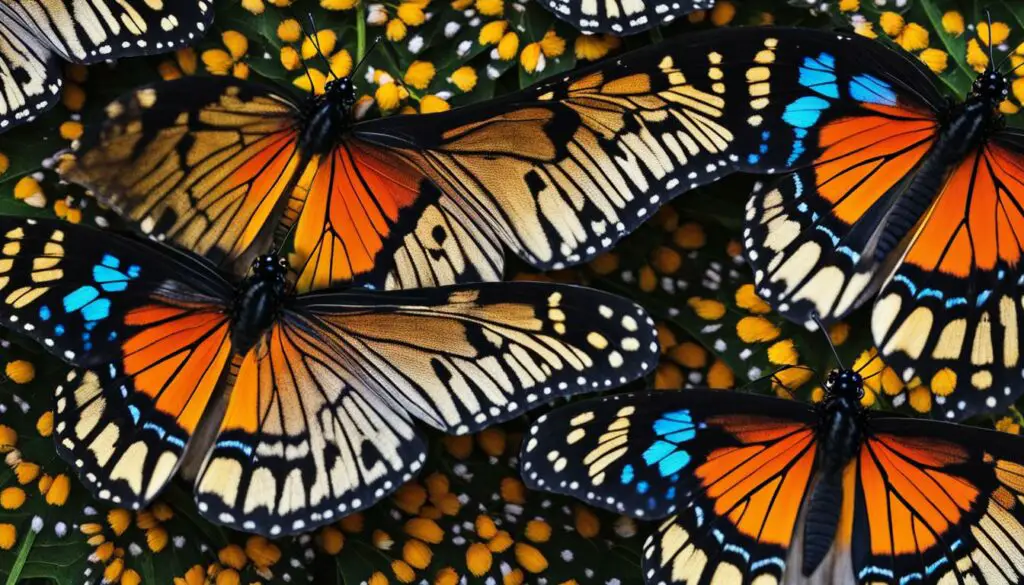
| Key Discoveries | Implications |
|---|---|
| Identification of specific genes responsible for wing pattern development | Insights into the genetic mechanisms behind butterfly wing patterns |
| Role of environmental factors in wing pattern expression | Understanding the interplay between genes and the environment in wing pattern evolution |
| Study of mimicry and coevolution in wing patterns | Uncovering the adaptive strategies of butterfly wing patterns |
Future Directions in Butterfly Wing Pattern Research
The study of butterfly wing patterns is a captivating field of research that continues to evolve and expand. As scientists uncover more about the genetic, environmental, and evolutionary factors that influence wing patterns, new questions arise, paving the way for exciting future directions in this area of study.
One of the key areas of exploration in future research is the identification of specific genes that control wing pattern development in different butterfly species. Understanding the genetic basis of wing patterns can provide insights into the mechanisms behind their formation and evolution. By mapping the genetic pathways and regulatory networks involved, researchers can deepen our understanding of how and why butterfly wings exhibit such a remarkable diversity of patterns.
Another intriguing avenue for future research is investigating the role of environmental factors in shaping butterfly wing patterns. While it is known that genes play a significant role, the interplay between genetics and the environment remains a complex puzzle. Scientists aim to unravel how factors such as temperature, humidity, and resource availability influence wing pattern expression. By studying these interactions, researchers can gain a more comprehensive understanding of the underlying mechanisms that contribute to the stunning variations observed in butterfly wings.
Mimicry and coevolution are additional areas that hold tremendous potential for future studies. The intricate relationship between wing patterns and mimicry, where certain species evolve to resemble toxic or unpalatable species, presents a fascinating field of exploration. Researchers aim to uncover the evolutionary processes and genetic mechanisms that enable butterflies to mimic the wing patterns of other species, providing insights into the coevolutionary dynamics between butterflies and their predators.
Unanswered Questions in Butterfly Wing Science
While significant progress has been made in understanding butterfly wing patterns, there are still unanswered questions that await further investigation. Some of these include:
- How do environmental cues influence the expression of specific wing patterns?
- What are the precise genetic pathways that regulate wing pattern development?
- How do different butterfly species evolve and maintain their distinct wing patterns?
- What ecological and evolutionary factors drive the convergence or divergence of wing patterns?
By addressing these and other unanswered questions, future research in butterfly wing pattern science holds the potential to deepen our understanding of the intricate beauty and adaptive significance of these enchanting creatures.
| Research Areas | Questions |
|---|---|
| Genetics | What are the specific genes that control wing pattern development? How do these genes interact to produce diverse patterns? |
| Environment | What role do environmental factors play in wing pattern expression? How do temperature, humidity, and resource availability affect wing patterns? |
| Mimicry and Coevolution | How do butterflies evolve to mimic the wing patterns of other species? What are the coevolutionary dynamics between butterflies and their predators? |
| Unanswered Questions | How do environmental cues influence wing pattern expression? What are the precise genetic pathways that regulate wing pattern development? How do different butterfly species evolve and maintain their distinct wing patterns? What ecological and evolutionary factors drive the convergence or divergence of wing patterns? |
Conclusion
In conclusion, butterfly wing patterns are a fascinating subject that showcases the beauty and complexity of nature’s artwork. The diversity of butterfly wing patterns is truly remarkable, with each species exhibiting its unique color variations, patterns, and motifs. These intricate designs serve various functions, from mate attraction to providing camouflage and warning signals for predators.
The genetics of wing pattern variation plays a significant role in shaping the stunning array of butterfly wing patterns observed in different species. Scientists have made remarkable advancements in understanding the genetic mechanisms behind wing pattern development, uncovering the genes responsible for these intricate designs.
Environmental factors also contribute to butterfly wing patterns, with temperature, humidity, and pigment availability influencing their expression. The interplay between genetic factors and the environment creates the mesmerizing diversity of butterfly wing patterns.
As we continue to study butterfly wing patterns, it is crucial to remember their cultural significance and their role in inspiring art, fashion, and symbolism. Additionally, efforts must be made to conserve and preserve butterfly habitats to ensure the continued existence of these mesmerizing wing designs. By educating ourselves and raising awareness about butterfly wing patterns, we can become advocates for their conservation and contribute to protecting these captivating creatures.
FAQ
What factors influence the variations in butterfly wing patterns?
Butterfly wing patterns are influenced by genetics and environmental factors. Specific genes control the development of wing patterns, while factors like temperature and pigment availability in the environment can also play a role.
What is the function of butterfly wing patterns?
Butterfly wing patterns serve various functions, including mate attraction, camouflage, and warning signals for predators. Some wings mimic leaves or twigs for protection, while others have bright colors to signal toxicity.
How do butterfly wing patterns contribute to conservation efforts?
By understanding the significance of different wing patterns and their ecological roles, we can work towards conserving butterfly species and their habitats. Protecting butterfly habitats and promoting sustainable practices are crucial for preserving these beautiful wing designs.
What is the cultural significance of butterfly wing patterns?
Butterfly wing patterns have been admired and celebrated in various cultures for centuries. They symbolize transformation, beauty, and spirituality, inspiring art, fashion, and symbolizing the intricate beauty of nature.
What is the current state of research on butterfly wing patterns?
Scientists are continuously studying butterfly wing patterns to uncover the mechanisms behind their development and variation. Through genetic studies, morphological analysis, and observations in the wild, researchers are gaining insights into the evolutionary processes and ecological interactions that shape butterfly wing patterns.
How can we protect and preserve butterfly wing patterns?
Protecting butterfly habitats, promoting sustainable practices, and raising awareness about the importance of butterfly conservation are key in preserving these mesmerizing natural wonders. By understanding and appreciating the diversity and significance of butterfly wing patterns, we can become advocates for their conservation.
What can we learn from butterfly wing patterns?
Learning about butterfly wing patterns provides a deeper appreciation for their beauty and ecological importance. By studying their diversity and significance, we can gain insights into biodiversity, evolutionary processes, and the intricate beauty of nature.
Are there recent scientific discoveries about butterfly wing patterns?
Recent scientific advancements have shed light on the intricate mechanisms behind butterfly wing pattern variation. Researchers have identified specific genes responsible for wing patterns and have unraveled the genetic and environmental factors that influence their expression.
What are the future directions in butterfly wing pattern research?
Butterfly wing pattern research is an ongoing field with many unanswered questions. Scientists continue to explore the mechanisms behind wing pattern variation, the role of genes and the environment, and the intricate processes of mimicry and coevolution. Future research holds the promise of expanding our knowledge of butterfly wing patterns.








